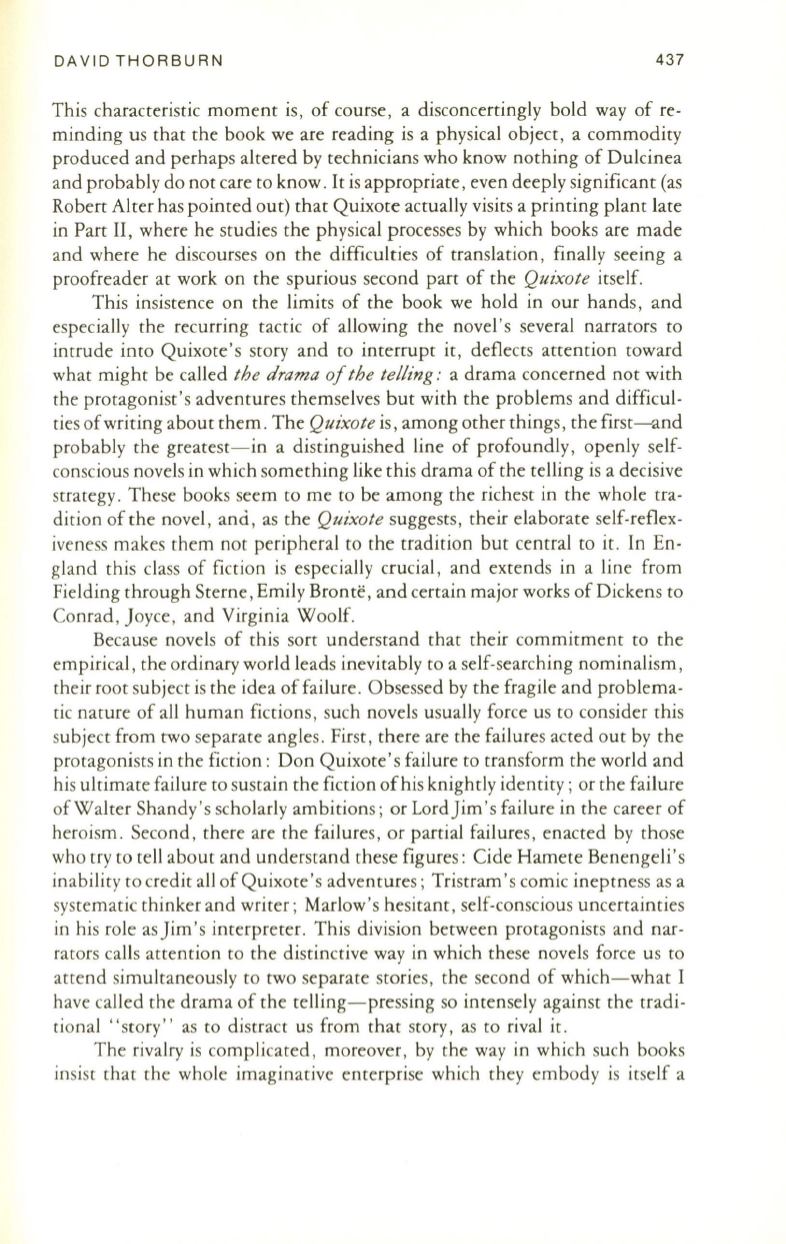
DAVID THORBURN
437
This characteristic moment is , of course , a disconcertingly bold way of re–
minding us that the book we are reading is a physical object, a commodity
produced and perhaps altered by technicians who know nothing of Dulcinea
and probably do not care to know.
It
is appropriate , even deeply significant (as
Robert Alter has pointed out) that Quixote actually visits a printing plant late
in Part II , where he studies the physical processes by which books are made
and where he discourses on the difficulties of translation , finally seeing a
proofreader at work on the spurious second part of the
Quixote
itself.
This insistence on the limits of the book we hold in our hands, and
especially the recurring tactic of allowing the novel's several narrators to
intrude into Quixote's story and to interrupt it, deflects attention toward
what might be called
the drama of the telling :
a drama concerned not with
the protagonist's adventures themselves but with the problems and difficul–
ties of writing about them . The
Quixote
is , among other things , the first-and
probably the greatest-in a distinguished line of profoundly , openly self–
conscious novels in which something like this drama of the telling is a decisive
strategy. These books seem to me to be among the richest in the whole tra–
dition of the novel, ana , as the
Quixote
suggests , their elaborate self-reflex–
iveness makes them not peripheral to the tradition but central
to
it. In En–
gland this class of fiction is especially crucial, and extends in a line from
Fielding through Sterne , Emily Bronte, and certain major works of Dickens to
Conrad , Joyce , and Virginia Woolf.
Because novels of this sort understand that their commitment to the
empirical, the ordinary world leads inevitably to a self-searching nominalism ,
their root subject is the idea of failure. Obsessed by the fragile and problema–
tic nature of all human fictions , such novels usually force us to consider this
subject from rwo separate angles. First , there are the failures acted out by the
protagonists in the fiction : Don Quixote's failure to transform the world and
his ultimate failure to sustain the fiction of his knightly identity ; or the failure
of Walter Shandy 's scholarly ambitions ; or LordJim' s failure in the career of
heroism . Second, there are the failures, or partial failures, enacted by those
who try to tell about and understand these figures: Cide Hamete Benengeli' s
inability
to
credit all of Quixote 's adventures; Tristram 's comic ineptness as a
systematic thinker and writer ; Marlow's hesitant , self-conscious uncertainties
in his role asJim 's interpreter. This division berween protagonists and nar–
rators calls attention to the distinctive way in which these novels force us to
attend simultaneously to rwo separate stories, the second of which-what I
have called the drama of the telling-pressing so intensely against the tradi–
tional " story" as to distract us from that story, as to rival it.
The rivalry is complicated, moreover, by the way in which such books
insist that the whole imaginative enterprise which they embody is itself a


